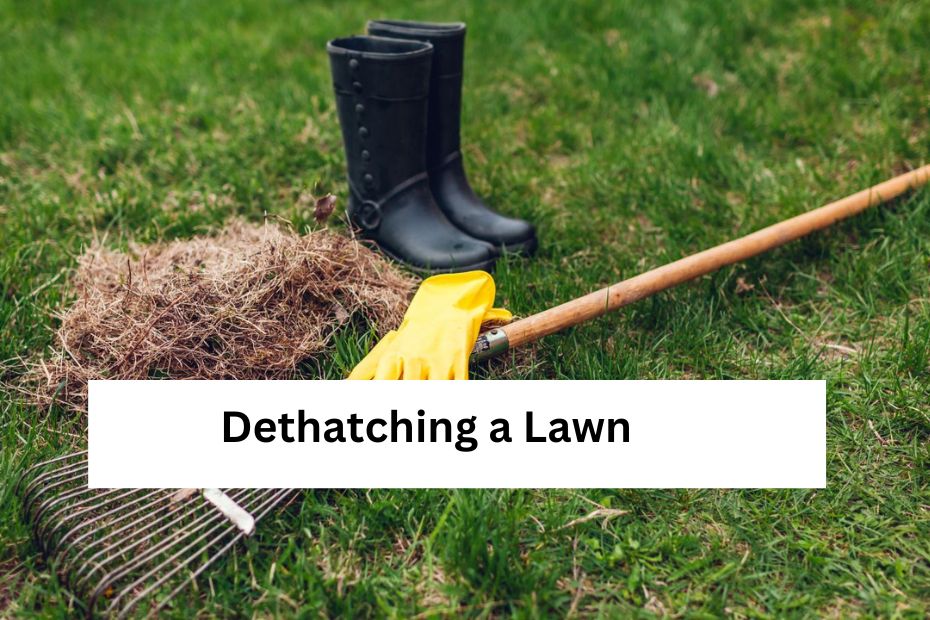Thick, lush grass is the pride of any homeowner, but underneath that green canopy, there may lurk a silent threat: thatch. Thatch is a layer of dead grass, roots, and debris that accumulates between the soil and the actively growing grass blades. While a thin layer of thatch can be beneficial, excessive buildup can suffocate your lawn, leading to a host of problems. Dethatching is the process of removing this layer to promote a healthier, more vibrant lawn.
Signs that Dethatching is Needed
Before diving into the dethatching process, it’s essential to identify whether your lawn actually needs it. Here are some telltale signs that dethatching may be necessary:
- Excessive thatch buildup: If you notice a spongy layer more than half an inch thick between the soil and the grass blades, it’s time to dethatch.
- Poor water penetration: Thatch prevents water from reaching the soil, leading to shallow root growth and water runoff.
- Reduced airflow to the soil: A thick layer of thatch restricts airflow, promoting the growth of fungi and other lawn diseases.
Best Time to Dethatch
Timing is crucial when it comes to dethatching your lawn. The best time to tackle this task depends on various factors, including the type of grass and the climate in your region. Generally, early spring or early fall are optimal seasons for dethatching, as the weather is cool and the grass is actively growing. However, avoid dethatching during periods of extreme heat or drought, as this can stress the lawn.
Tools and Equipment
Before you begin dethatching, gather the necessary tools and equipment:
- Dethatching rake: Ideal for small lawns, a dethatching rake features sharp blades or tines designed to cut through the thatch and pull it up to the surface.
- Power dethatcher: For larger lawns, consider renting or purchasing a power dethatcher, also known as a vertical mower or a power rake. These machines use rotating blades or tines to remove thatch more efficiently.
- Lawn aerator: While not essential for dethatching, a lawn aerator can help improve soil compaction and promote better water and nutrient absorption after dethatching.
Preparation Before Dethatching
Before firing up your dethatching equipment, take the following steps to prepare your lawn:
- Mow the lawn: Trim the grass to a shorter height than usual to make dethatching more effective.
- Water the lawn: Thoroughly water the lawn a day or two before dethatching to soften the thatch and make it easier to remove.
- Check for obstacles: Remove any rocks, sticks, or other debris from the lawn that could damage the dethatching equipment or cause injury.
Dethatching Process
Now that your lawn is prepped and ready, it’s time to get to work:
- Setting the dethatcher depth: Adjust the dethatching equipment to the appropriate depth, typically around ¼ to ½ inch deep, depending on the thickness of the thatch.
- Overlapping passes: Start dethatching by making overlapping passes across the lawn in a systematic pattern, such as rows or circles. Avoid going over the same area multiple times, as this can damage the grass.
- Proper disposal of thatch: Once you’ve finished dethatching, gather up the loosened thatch and debris and dispose of it properly. You can compost the thatch if it’s not too thick or dispose of it in yard waste bags.
Aftercare
Dethatching is just the first step in revitalizing your lawn. Follow these aftercare tips to ensure the best results:
- Watering the lawn: Continue to water the lawn regularly to promote deep root growth and recovery.
- Fertilizing and overseeding: After dethatching, fertilize the lawn with a balanced fertilizer to provide essential nutrients. Consider overseeding to fill in any bare patches and encourage thick, healthy turf.
- Monitoring the lawn’s recovery: Keep an eye on your lawn in the weeks following dethatching to ensure that it’s recovering well. If necessary, make adjustments to your lawn care routine to address any issues that arise.
Benefits of Dethatching
Dethatching offers several benefits for your lawn’s health and appearance:
- Improved air and water circulation: Removing thatch allows air, water, and nutrients to penetrate the soil more effectively, promoting healthier root growth.
- Enhanced nutrient absorption: Without a thick layer of thatch blocking their path, grass roots can absorb nutrients more efficiently, leading to greener, more vigorous growth.
- Healthier lawn growth: By eliminating the conditions that favor thatch buildup, dethatching encourages thicker, more resilient turf that can better withstand environmental stressors.
Common Mistakes to Avoid
While dethatching can work wonders for your lawn, it’s essential to avoid these common pitfalls:
- Dethatching too frequently: Overdethatching can damage the grass and disrupt the soil ecosystem, so only dethatch when necessary.
- Using the wrong equipment: Make sure you’re using the right dethatching equipment for your lawn’s size and condition to avoid causing damage.
- Ignoring proper aftercare: After dethatching, be sure to follow up with appropriate watering, fertilizing, and overseeding to support your lawn’s recovery.
FAQs
- How often should I dethatch my lawn?
- Dethatching frequency depends on the rate of thatch buildup in your lawn. Generally, it’s recommended to dethatch when the thatch layer exceeds half an inch in thickness.
- Can I dethatch my lawn by hand?
- While small areas can be dethatched manually with a rake, larger lawns may require the use of a power dethatcher for more efficient results.
- Is dethatching necessary for all types of grass?
- Dethatching is beneficial for most types of grass, especially those prone to thatch buildup, such as Kentucky bluegrass and zoysiagrass.
- Will dethatching damage my lawn?
- When done correctly and at the appropriate time, dethatching should not damage your lawn. However, improper dethatching techniques or excessive dethatching can harm the grass and soil.
- Can I dethatch my lawn in the rain?
- It’s best to dethatch when the lawn is dry to achieve optimal results. Dethatching in wet conditions can make the process more challenging and may result in uneven or patchy removal of thatch.






